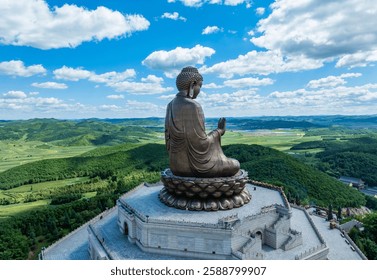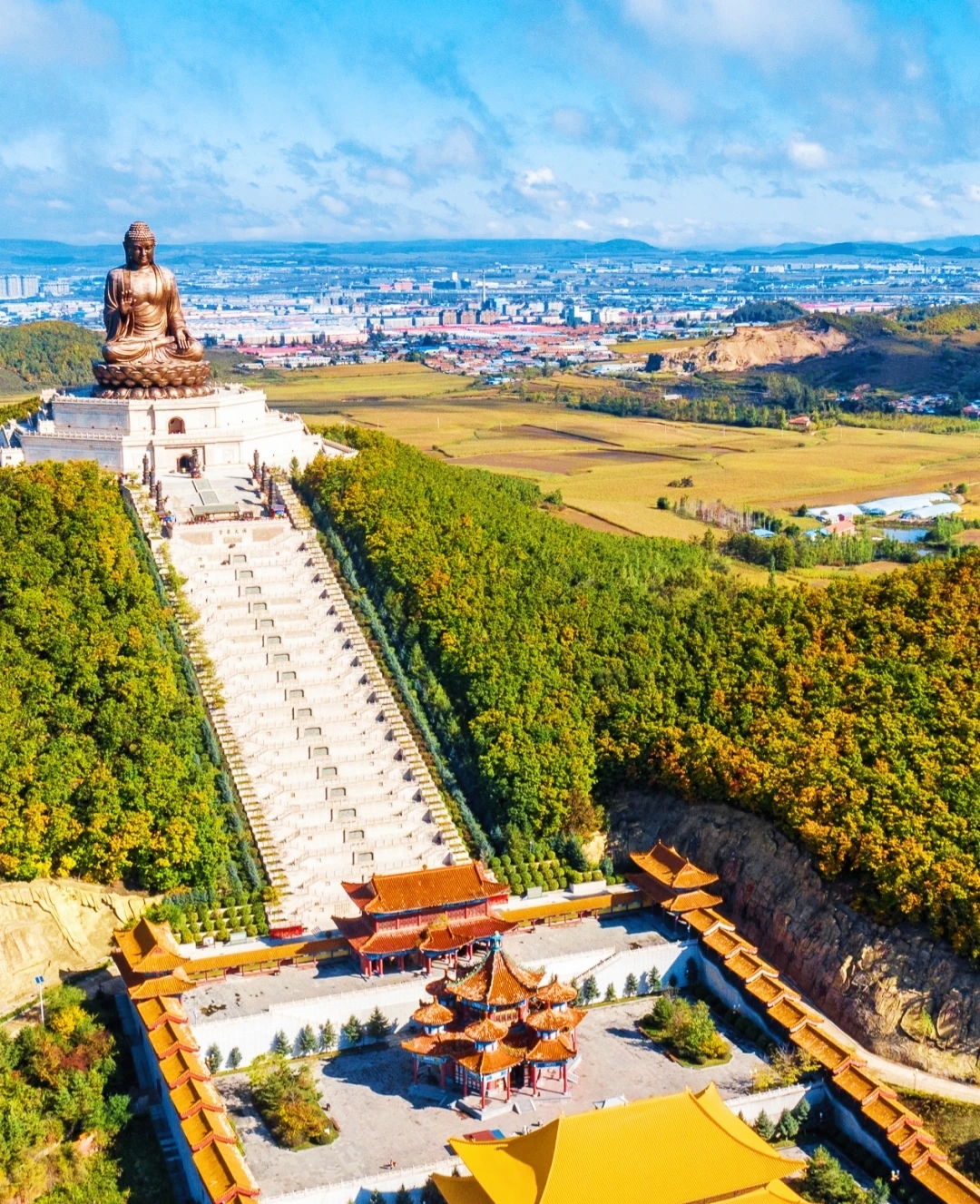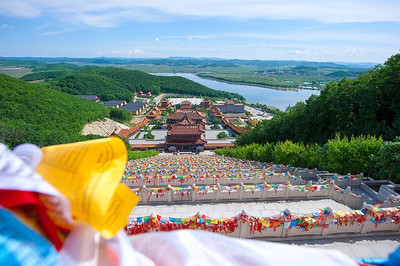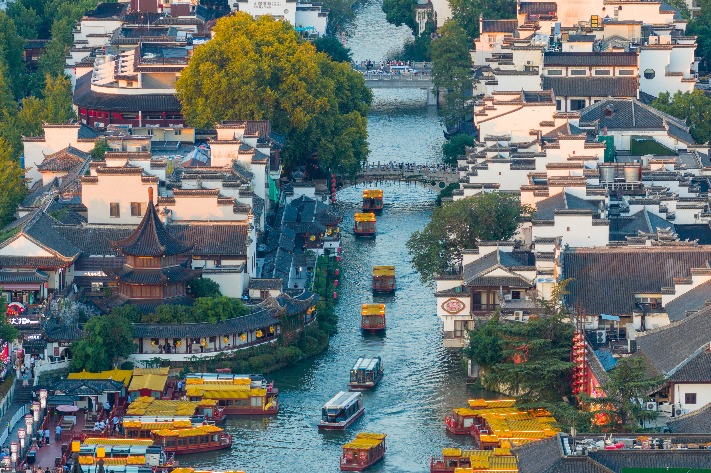Top Activities to Enjoy in Dunhua Liudingshan Cultural Tourism Area

An Essential Guide to Visiting Dunhua_Liudingshan_Cultural_Tourism_Area
Nestled in the picturesque landscape of Jilin Province, the Dunhua Liudingshan Cultural Tourism Area beckons travelers with its blend of breathtaking natural beauty and rich cultural heritage. This captivating destination, often referred to as the “spiritual heart of the Northeast,” is home to the majestic Liuding Mountain and a myriad of attractions that celebrate Buddhism, history, and the vibrant traditions of the Manchu people.
As you wander through this enchanting region, the towering bronze statue of Sakyamuni at the summit of Liuding Mountain serves as a striking focal point, casting a serene presence over the landscape. The area is also renowned for Zhengjue Temple, the largest bhikshuni monastery in the world, where the architectural elegance and spiritual ambiance invite visitors to reflect and rejuvenate.
Beyond the spiritual allure, the Liudingshan Cultural Tourism Area offers a fascinating glimpse into the past with the ancient tombs of the Bohai Kingdom and the Qing Ancestral Temple, both steeped in history and culture. Each site tells a story, weaving together the legacies of ancient civilizations and the enduring spirit of the Manchu heritage.
Whether you’re seeking a tranquil retreat, a cultural deep dive, or simply an adventure amidst stunning landscapes, Dunhua Liudingshan Cultural Tourism Area promises an unforgettable experience that resonates with the soul. Get ready to embark on a journey that harmonizes spirituality, nature, and history in one of China’s hidden gems.
In This Guide
- An Essential Guide to Visiting Dunhua_Liudingshan_Cultural_Tourism_Area
- The Rich History and Legends of Dunhua_Liudingshan_Cultural_Tourism_Area
- Main Highlights: What You Absolutely Can’t Miss
- Planning Your Visit: A Practical Guide
- Tickets: Prices, Booking, and Tips
- How to Get There: A Complete Transportation Guide
- Local Cuisine and Accommodation Nearby
- Frequently Asked Questions
- Final Thoughts on Your Trip
The Rich History and Legends of Dunhua_Liudingshan_Cultural_Tourism_Area
Nestled in the breathtaking landscapes of Jilin Province, the Dunhua Liudingshan Cultural Tourism Area is a treasure trove of history and legend, where the past intertwines seamlessly with the present. This culturally rich region is not just a feast for the eyes but also a sanctuary for the soul, attracting visitors eager to explore its storied heritage and spiritual significance.
The area is renowned for its most prominent feature, Zhengjue Temple, which stands as the largest bhikshuni practice center in the world and the foremost Buddhist temple in Northeast China. This temple, originally built during the Guangxu period of the Qing Dynasty, embodies centuries of devotion and architectural splendor. Visitors are greeted by the majestic bronze seated statue of Sakyamuni at the mountain’s peak, a sight that inspires awe and reverence.
As you journey through the Liudingshan area, you’ll discover numerous historical sites, including the Qingzu Temple, dedicated to the ancestors of the Qing Dynasty. This temple commemorates the birthplace of Bukuli Yongshun, the founder of the Qing Dynasty. The Qing Ancestral Temple complex consists of three major buildings and showcases the integration of shaman culture with Buddhist practices, serving as a spiritual haven for the Manchu people seeking to connect with their roots.
The ancient tombs of the Bohai Kingdom, located within the Liudingshan area, offer a glimpse into a bygone era. Established in 698 AD, the Bohai Kingdom was a significant power in its time, and its royal tombs reflect the unique burial customs and artistry of the period. Among these ancient sites is the tomb of Princess Zhenhui, which has yielded precious artifacts that illuminate the rich history of this once-flourishing kingdom.
But the legends of Dunhua extend beyond its physical landmarks. The region is steeped in tales of the Manchu people’s origins, particularly the story of Bukuli Yongshun, who, according to legend, was born from the celestial union of a goddess and a fruit. This narrative emphasizes the spiritual and cultural significance of Dunhua as a place of divine favor and historical importance.
Today, Dunhua Liudingshan Cultural Tourism Area invites international travelers to immerse themselves in its unique blend of natural beauty, historical richness, and spiritual depth. Whether you are climbing the serene paths to Zhengjue Temple or marveling at the artistry of the Jade Buddha Garden, each step taken within this sacred landscape is a journey through time, connecting you to the ancient spirits that continue to inspire and guide the region today.

Dunhua_Liudingshan_Cultural_Tourism_Area.
Main Highlights: What You Absolutely Can’t Miss
When visiting the Dunhua Liudingshan Cultural Tourism Area, you are stepping into a realm where rich history intertwines with breathtaking natural beauty. Here are the main highlights you absolutely cannot miss:
Zhengjue Temple (正觉寺)
At the heart of the Liudingshan Cultural Tourism Area lies the magnificent Zhengjue Temple, the largest bhikshuni practice site in the world. Established during the Qing Dynasty, this temple complex is not only a spiritual sanctuary but also an architectural marvel. As you enter, you’ll be greeted by Fayin Square, flanked by stunning double-eave halls, including the majestic Daxiong Hall. Here, admire the intricately carved dragon columns and the three camphor wood Buddhas that radiate serenity.
The Golden Buddha (金鼎大佛)
Ascend to the pinnacle of the mountain to behold the awe-inspiring 48-meter tall bronze seated statue of Sakyamuni, dubbed the Golden Buddha. This iconic figure, set against a backdrop of lush mountains and blue skies, serves as a powerful symbol of peace and enlightenment, drawing visitors and pilgrims alike. Standing next to this monumental statue, you’ll feel a profound sense of tranquility and reverence.
Jade Buddha Garden (玉佛苑)
After exploring the temple, a visit to the Jade Buddha Garden is essential. Nestled in a natural round mountain depression, this three-story pavilion houses a stunning reclining Buddha carved from a single piece of Burmese jade. The exquisite craftsmanship and lifelike features of the Buddha, flanked by towering statues of his ten disciples, create an environment of peaceful reflection.
Qingzu Temple (清祖祠)
For those interested in history, the Qingzu Temple commemorates the birthplace of the Qing royal family. This site consists of three main structures: the Temple of the First Ancestor, the Temple of Heavenly Lady, and the Hall of Ancestors. Here, you can delve into the rich tapestry of Manchu culture and heritage, making it a significant stop for anyone looking to understand the roots of the Qing Dynasty.
Ancient Tombs of the Bohai Kingdom (渤海古墓群)
A short journey will lead you to the ancient tombs dating back to the Bohai Kingdom. This significant archaeological site features over 200 tombs, including the notable tomb of Princess Zhenhui. As you wander through these ancient burial grounds, you’ll uncover stories of a bygone era, with artifacts and inscriptions that offer glimpses into the lives of the royal family of the Bohai Kingdom.
Natural Beauty
Beyond the cultural landmarks, the Liudingshan area is enveloped by stunning natural landscapes. The serene mountain scenery, crystal-clear streams, and vibrant flora make this a perfect spot for hiking and nature walks. Whether you visit in the blooming spring or during the vibrant autumn foliage, the area offers a picturesque backdrop that enhances your experience.
Practical Tips
- Opening Hours: The area is open daily from 8:00 AM to 5:00 PM, with the last admissions at 4:00 PM.
- Tickets: Admission fees are approximately 120 yuan, which includes access to the main attractions.
- Transport: The site is accessible by car, and there are shuttle services within the area for convenience.
Visiting the Dunhua Liudingshan Cultural Tourism Area is not just a journey through time; it’s a chance to connect with the spiritual and cultural essence of the region. Make sure these highlights are on your itinerary for an unforgettable experience!

Dunhua_Liudingshan_Cultural_Tourism_Area.
Planning Your Visit: A Practical Guide
When planning your visit to the stunning Dunhua Liudingshan Cultural Tourism Area, there are several practical considerations to ensure a smooth and enjoyable experience. From transportation to ticketing and attractions, this guide will help you navigate your journey to this beautiful cultural site in Jilin Province, China.
Getting There
Liudingshan Cultural Tourism Area is conveniently located in the southern suburbs of Dunhua City in the Yanbian Korean Autonomous Prefecture. If you’re traveling by air, the nearest major airport is in Changchun, which is about a three-hour drive away. Alternatively, Dunhua has a high-speed rail station, making it easily accessible by train from various cities in China.
Once you arrive in Dunhua, taxis and ride-sharing services are readily available to take you to the tourism area. It’s recommended to have your accommodation arranged in advance, as there are several hotels and guesthouses nearby, some of which offer great packages that include entrance tickets to the cultural area.
Opening Hours & Tickets
The Liudingshan Cultural Tourism Area is open daily from 8:00 AM to 5:00 PM, with the last admission at 4:00 PM. It’s advisable to plan your visit for at least half a day to fully appreciate the site’s offerings.
As for tickets, the price is generally around 100 RMB, with an additional 10 RMB for the shuttle bus within the scenic area. Purchasing tickets online can sometimes offer discounts, so check platforms like Trip.com for any promotions before your visit.
Key Attractions
There are several must-see attractions within the Liudingshan Cultural Tourism Area:
-
Zhengjue Temple: This is the largest bhikshuni temple in the world and a central feature of the area. The temple complex includes multiple halls, with the Main Hall featuring impressive sculptures and intricate architecture. Don’t miss the stunning Guanyin Hall, home to a breathtaking statue of Guanyin with thousands of hands.
-
Jade Buddha Garden: Located in a serene natural setting, this garden houses a magnificent reclining Buddha carved from a single piece of Burmese jade. The surrounding structures offer a unique view of Buddhist art and culture.
-
Qingzu Temple & Ancient Tombs: If time permits, explore these historical sites that showcase the rich heritage of the region. The Qingzu Temple is dedicated to the ancestors of the Qing Dynasty, while the ancient tombs reveal artifacts from the Bohai Kingdom.
Tips for Your Visit
-
Dress Comfortably: Wear comfortable shoes as you’ll be walking a lot, especially on uneven terrain leading to the temple and other attractions.
-
Respect Local Customs: As you are visiting a cultural and religious site, be mindful of your surroundings. Maintain a respectful demeanor, especially in temple areas, and adhere to any posted guidelines.
-
Stay Hydrated: Bring water with you, especially during the warmer months, as you may spend several hours exploring the area.
-
Explore Surrounding Areas: Take advantage of the local culture by visiting nearby attractions, including ethnic Korean villages and traditional dining options to taste local delicacies.
-
Plan for the Weather: Check the forecast before you go, as the area can experience varying weather conditions. Dress in layers and be prepared for rain or sun.
By following this guide, you can immerse yourself in the rich cultural and spiritual heritage of the Dunhua Liudingshan Cultural Tourism Area. Enjoy your adventure in this beautiful region of China!

Dunhua_Liudingshan_Cultural_Tourism_Area.
Tickets: Prices, Booking, and Tips
When planning your visit to the stunning Liudingshan Cultural Tourism Area in Dunhua, it’s essential to know the ticketing details to maximize your experience. Here’s everything you need to know about ticket prices, booking options, and helpful tips for a smooth visit.
Ticket Prices
As of 2025, the standard admission fee for the Liudingshan Cultural Tourism Area is CNY 120 (approximately USD 18), which grants you access to the main attractions, including the renowned Zhengjue Temple and the majestic Bronze Buddha statue. Visitors should note that there may be additional charges for guided tours or transportation within the site, which can typically be around CNY 10 for the shuttle service.
For students and certain groups, discounted tickets are available—be sure to carry relevant identification to benefit from these offers. Keep in mind that prices may vary slightly depending on the season or special events, so checking the official website or local tourism boards close to your visit is advisable.
Booking Options
Tickets can be conveniently purchased online through various travel platforms like Trip.com, where you can often find promotional deals that might lower the cost to around CNY 98. This can be particularly useful during peak tourist seasons when demand is high.
Alternatively, tickets are available for on-site purchase at the entrance. However, considering the popularity of the site, especially during weekends and holidays, it’s recommended to book in advance to avoid long waiting times.
Opening Hours
The Liudingshan Cultural Tourism Area operates from 8:00 AM to 5:00 PM, with the last admission at 4:00 PM. To fully enjoy the scenic beauty and cultural richness, plan to spend at least 3 to 4 hours exploring the area. Arriving early will also give you a chance to experience the tranquility of the site before it becomes busier later in the day.
Tips for Your Visit
-
Wear Comfortable Shoes: The area is expansive and involves a fair amount of walking, especially if you plan to explore the various temples and monuments. Comfortable footwear will make your visit more enjoyable.
-
Respect the Culture: As this is a significant cultural and religious site, visitors are encouraged to maintain decorum. Dress modestly and be mindful of local customs, especially when visiting temples.
-
Bring Cash: While many places accept cards, it’s a good idea to have some local currency on hand for small purchases like offerings or snacks from local vendors.
-
Plan Your Route: Given the size of the area, it can be beneficial to have a rough itinerary. Prioritize must-see spots like the Zhengjue Temple and the Bronze Buddha, and consider how much time you’d like to dedicate to each.
-
Stay Hydrated and Snack Smart: While exploring, remember to stay hydrated, especially during warmer months. Pack some light snacks to keep your energy up.
By preparing ahead and understanding the ticketing process, you can fully immerse yourself in the beauty and spirituality of the Liudingshan Cultural Tourism Area. Enjoy your journey through this remarkable blend of nature and culture!
How to Get There: A Complete Transportation Guide
Reaching the Liudingshan Cultural Tourism Area in Dunhua, Jilin, is a journey that offers a blend of scenic views and cultural richness. Here’s your ultimate guide to navigating this beautiful destination with ease.
By Air
For international travelers, the nearest major airport is Changchun Longjia International Airport (CGQ), located about 240 kilometers away from Dunhua. From the airport, you can take a domestic flight to Yanji Chaoyangchuan Airport (YNJ), which is closer to Dunhua. Upon arrival at Yanji, you can opt for a taxi or book a ride-sharing service to reach Dunhua, which is approximately a 90-minute drive.
By Train
Dunhua is well-connected by rail. The Dunhua Railway Station serves as a hub for trains from major cities. High-speed trains from Changchun or Shenyang can bring you directly to Dunhua in under three hours. Once you arrive at the station, taxis are readily available to take you to the Liudingshan Cultural Tourism Area.
By Bus
For a more economical option, long-distance buses operate from various cities in Jilin Province directly to Dunhua. The bus station is centrally located, and you can find frequent departures. The journey from Changchun takes about four to five hours. Upon arrival in Dunhua, taxis and local buses can take you to the tourism area.
Local Transportation
Once you’re in Dunhua, getting to the Liudingshan Cultural Tourism Area is straightforward. The area is about 3 kilometers south of the city center. Here are your options:
-
Taxi: Taxis are plentiful and can take you directly to the entrance of the tourism area. A ride from downtown Dunhua to Liudingshan usually takes around 10-15 minutes.
-
Public Bus: Local buses provide service to the Liudingshan area. Look for buses heading south towards the mountain; they are generally inexpensive and a good way to experience local life.
-
Car Rentals: If you prefer to explore at your own pace, consider renting a car. Several rental services operate in Dunhua, allowing for greater flexibility in visiting nearby attractions.
On Foot
Once inside the Liudingshan Cultural Tourism Area, much of the sightseeing can be done on foot. The major attractions, including the Zhengjue Temple and Jade Buddha Garden, are interconnected, making it easy to stroll between them and enjoy the stunning natural surroundings.
Final Tips
-
Entry Fees: The entrance fee for the Liudingshan Cultural Tourism Area is around 100 CNY (approximately 15 USD), with an additional fee for shuttle buses within the area.
-
Operating Hours: The site is generally open from 8:00 AM to 5:00 PM, with the last admission at 4:00 PM. Plan your visit accordingly to make the most of your time.
-
Travel Insurance: Ensure you have travel insurance that covers any unforeseen circumstances during your journey.
This transportation guide will help you navigate your way to the Liudingshan Cultural Tourism Area effortlessly, allowing you to focus on soaking in the rich cultural heritage and breathtaking landscapes that await you! Safe travels!

Dunhua_Liudingshan_Cultural_Tourism_Area.
Local Cuisine and Accommodation Nearby
When visiting the Dunhua Liudingshan Cultural Tourism Area, you not only immerse yourself in the rich Buddhist heritage and stunning natural scenery, but also have the opportunity to savor some delightful local cuisine and find comfortable accommodations nearby.
Culinary Delights
1. Korean BBQ and Cold Noodles
Experience the region’s unique twist on Korean cuisine with Korean BBQ. The marinated meats, grilled to perfection, are often served alongside cold noodles (冷面), a refreshing dish that varies in flavor from other regions of China. The tangy sauce and chewy noodles make for a satisfying meal after a day of exploration.
2. Wild Mushroom Hotpot
For those who enjoy hearty meals, wild mushroom hotpot is a must-try. Utilizing fresh local mushrooms, this dish offers a rich and earthy flavor that warms you up, especially during the cooler months. It’s not just a meal; it’s a communal experience, perfect for sharing with fellow travelers.
3. Dunhua Pig Oil Cake
Another local specialty is Dunhua pig oil cake (猪油渣糕). This dessert combines the sweetness of cake with the savory flavor of rendered pig fat, delivering a unique taste that exemplifies local culinary creativity. Each bite brings a delightful surprise!
4. Specialty Pan-Fried Buns
Don’t miss out on the pan-fried buns (水煎包), known for their thin, crispy skin and generous fillings. These buns are a local favorite, packed with juicy meat and vegetables, making them an ideal snack for a busy day of sightseeing.
Accommodation Options
1. Dunhua Qianxi Hotel
Just a short drive from the Liudingshan Cultural Tourism Area, the Dunhua Qianxi Hotel offers comfortable accommodations with modern amenities. Guests appreciate the spacious rooms and friendly service. Plus, its location makes it easy to access the nearby attractions, including the majestic Zhengjue Temple.
2. Huayuan Hotel
For a more homely feel, consider the Huayuan Hotel. Located within walking distance of the cultural area, this hotel provides a tranquil atmosphere with well-furnished rooms. Guests often rave about the cleanliness and the helpful staff who can assist with travel arrangements.
3. Local Guesthouses
For a truly immersive experience, stay at one of the local guesthouses. These family-run establishments often provide a cozy atmosphere and home-cooked meals, allowing you to experience the warmth of local hospitality while enjoying traditional dishes.
Final Thoughts
Whether you opt for the hearty flavors of local cuisine or the comfortable ambiance of nearby accommodations, your visit to the Dunhua Liudingshan Cultural Tourism Area will be enriched by these delightful experiences. Enjoy your journey through this cultural gem that beautifully merges history, spirituality, and nature!

Dunhua_Liudingshan_Cultural_Tourism_Area.
Frequently Asked Questions
Frequently Asked Questions about Dunhua Liudingshan Cultural Tourism Area
1. What are the opening hours for the Liudingshan Cultural Tourism Area?
The Liudingshan Cultural Tourism Area is open daily from 08:00 AM to 05:00 PM. Please note that the last admission is at 04:00 PM, so plan your visit accordingly to enjoy all the attractions.
2. How do I get to the Liudingshan Cultural Tourism Area from Dunhua city center?
You can easily take a taxi from the city center, which should take around 20 minutes. Public transportation options may also be available, but taxis are often the most convenient choice.
3. What are the ticket prices for the attractions?
The general admission fee is approximately CNY 120 per person. This may vary slightly based on specific promotions or seasonal pricing, so it’s best to check online or inquire at the entrance.
4. What are the must-see attractions within the Liudingshan Cultural Tourism Area?
Key highlights include the Zhengjue Temple, home to the world’s largest bhikshuni practice site; the majestic 48-meter tall bronze seated statue of Sakyamuni; the Jade Buddha Garden; and the Qingzu Temple, which honors the origins of the Qing dynasty.
5. Is there a recommended duration for visiting the area?
Most visitors suggest spending about half a day to a full day exploring the Liudingshan Cultural Tourism Area. This allows ample time to visit the main attractions, enjoy the scenery, and take part in any cultural experiences.
6. Are there dining options available within the tourism area?
While there may be limited dining options within the site itself, nearby Dunhua city offers various restaurants and local eateries where you can enjoy traditional Korean and Chinese cuisine. It’s advisable to explore these options after your visit.
7. What should I wear when visiting the Liudingshan Cultural Tourism Area?
Comfortable walking shoes are highly recommended, as the area involves some uphill walking and exploration of various temple sites. Dress in layers to accommodate changing weather conditions, especially if you plan to hike.
8. Are there any cultural etiquette tips for visiting the religious sites?
When visiting temples, it is important to dress modestly and maintain a respectful demeanor. Avoid loud conversations, and refrain from taking photos in restricted areas. Additionally, be mindful of local customs regarding offerings and prayer practices.
Final Thoughts on Your Trip
As you wrap up your journey through the enchanting landscapes and rich cultural tapestry of the Dunhua Liudingshan Cultural Tourism Area, take a moment to reflect on the harmonious blend of nature and spirituality that defines this remarkable destination. From the towering bronze statue of Sakyamuni, evoking a sense of awe and reverence, to the serene pathways lined with ancient temples, your visit here is not merely a sightseeing adventure, but a soulful pilgrimage into the heart of Buddhist heritage and Manchu history.
The stunning views from the mountain peaks invite introspection, offering a tranquil escape from the hustle of everyday life. The intricate architecture of Zhengjue Temple, with its beautifully crafted halls and the captivating Jade Buddha Garden, serves as a reminder of the artistry and devotion that permeate this sacred space. Each step through the ancient tombs and the Qing Ancestral Temple deepens your appreciation for the stories embedded in this land, where history whispers through the rustling leaves and flowing waters.
As you prepare to depart, carry with you the serenity and inspiration that Liudingshan has imparted. Whether it’s the peaceful energy of the temples, the breathtaking natural beauty surrounding you, or the rich cultural narratives that have unfolded here, let this experience enrich your soul and ignite a passion for exploration. We hope you leave with cherished memories and a renewed spirit, ready to share the magic of Dunhua with friends and loved ones. Safe travels and may your adventures continue to inspire and enlighten!